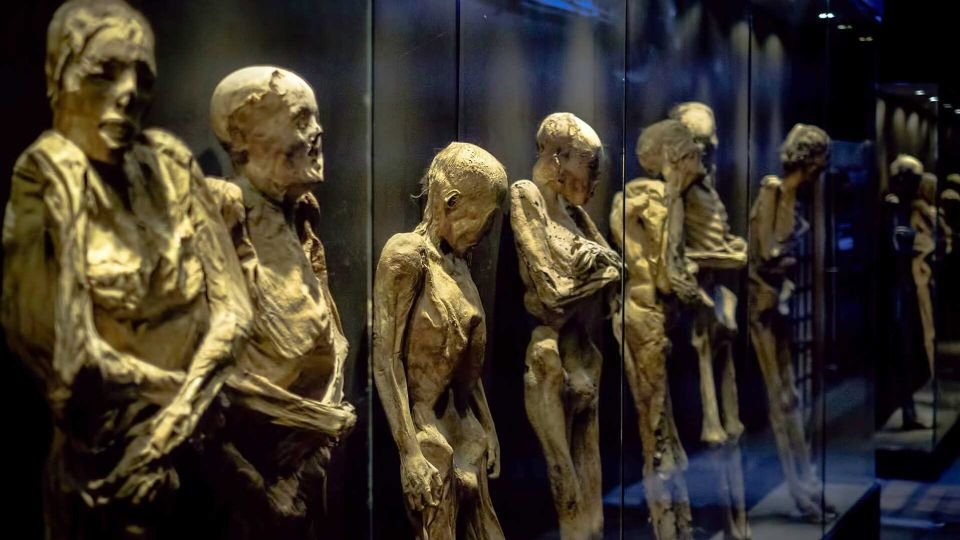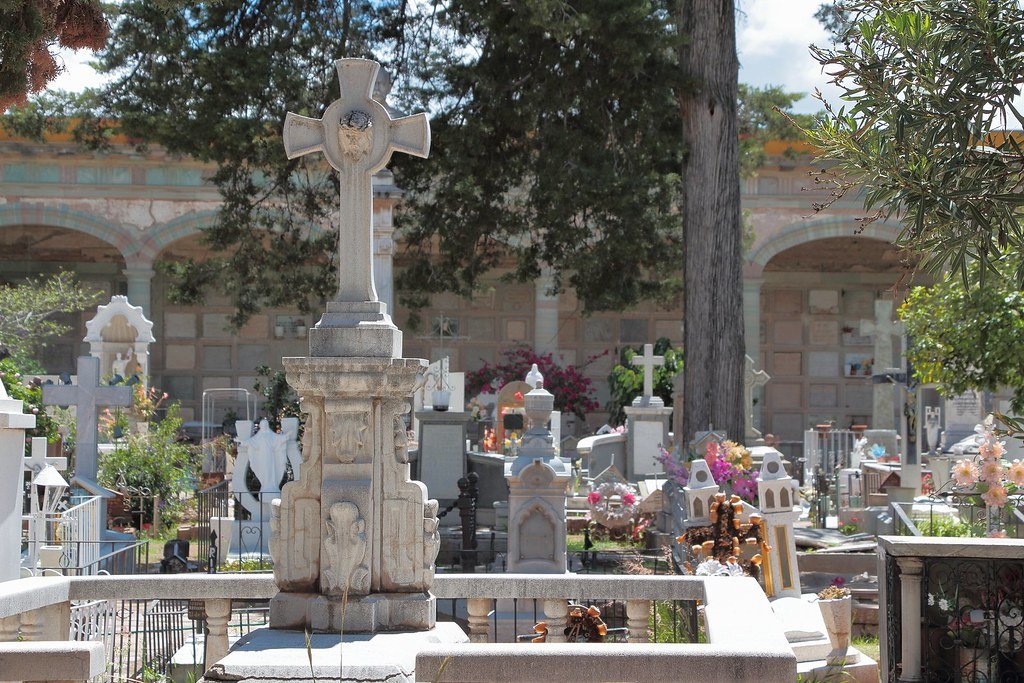Death and Dignity: The Exploitation of Corpses in Guanajuato’s Mummy Museum
Marlene Melissa Davila | March 4, 2021
Naked corpses stand alongside each other with expressions of suffering in the dark corridors of the maze-like museum. Where everything is seemingly arranged to shock the viewer. “Welcome to the Mummy Museum, it’s 100 pesos for two tickets.” Says a woman behind the counter.
It’s been almost 150 years since the state of Guanajuato in Mexico opened its Mummy Museum with more than one hundred mummified corpses ranging from 7-month-old fetuses to 70-year-old men and women.
Over the last 10 years this museum has attracted thousands of visitors, all hoping to catch a morbid glimpse of the extraordinary effects that the mineral rich soil can have on the dead.
Guanajuato Mummy Museum. Image credit: La Silla Rota Guanajuato, 2020.
The mummified corpses were originally discovered in 1865 in the Santa Paula Cemetery of Guanajuato where many families, unfortunately, were unable to afford paying the 5-year fee to maintain their loved ones buried (this still happens because of the 1859 Cemetery Secularization Law, where it states that families wishing to keep their loved ones in the cemetery must renew the contract after five years as the space is lent to them temporarily).
In many Latin American countries like Mexico, public cemeteries have laws for exhuming corpses after 5 to 10 years after their burial due to the lack of space and high mortality rates in populous cities. If a citizen is wealthy enough, they can either pay for a permanent ossuary in a public cemetery (with an average cost of 200 dollars) or have their loved ones buried in a private one, which is significantly more expensive.
Even with national laws that oblige similar burial rituals and cemetery conditions such as The Cemetery Secularization Law, the inequalities between cemeteries are evident. In private cemeteries, the grass is green and cut, the tombstones are clean, and the walls are freshly painted. Whereas in public cemeteries, one can find trash on the dried-out grass and a lack of cleanliness in tombstones and wall niches.
It is estimated that in Mexico City only three out of ten families pick up their loved ones remains after they’ve been exhumed in a public cemetery,(1) showing again a sign of an unequal society, where the rich have access to additional privileges, even in death.
Panteón Municipal de Santa Paula en Guanajuato. Image credit: Carlos Mancilla, 2016.
Having had a large sum of money with a will that states where one wants to be buried, or a family belonging to the upper class will give a corpse special treatment: expensive metal caskets, a thorough embalming process and a place in an ornamented permanent crypt.
When exhumation work began in nineteenth-century Guanajuato, many corpses were revealed to have been mummified, permanently preserving pained expressions and lifelike skin. It is believed that the first exhumed corpse was a doctor by the name of Remigio Leroy, a French citizen who lived in Guanajuato for several years and had no surviving family members in the city. Guanajuato’s fascination for this discovery continued to grow as hundreds of people flocked to the cemetery grounds to gaze at Leroy’s corpse and discuss what may have caused his mummification.
Today, scientific evidence proves that the causes for mummification in Guanajuato are a combination of its natural minerals and soil conditions, but, back then, many thought of it as the work of the devil.
Soon enough, other mummified corpses were discovered as well, and the Mayor knew this could potentially bring additional funds for the city if they started selling tickets to see the corpses, like a circus attraction where the dead couldn’t refuse being exposed in such a manner.
Caraballo Perichi in his analytical article: El museo de las momias de Guanajuato ¿Momias o cadáveres? La explotación comercial del morbo tanático recounts that by 1894 there were already 67 corpses of children, pregnant women, and the elderly stacked in a basement next to the cemetery. The whole city knew about this sketchy business but kept visiting to satisfy their morbid curiosity.
Today, it is well known that Mexico is a very religious country, and that Guanajuato is the state with the highest percentage of Catholics. Nevertheless, people weren’t turned away from this attraction. Everyone wanted to visit this new “Haunted House”.
The city continued profiting from tourist visits throughout the twentieth century as well, and became even more famous after the 1972 film: Santo contra las Momias de Guanajuato ,was released. Directed by Federico Curiel, this film depicts a luchador (wrestler in English), who fights the mummies of Guanajuato in order to save the city. The mummies are depicted as evil entities walking around and haunting citizens, similar to George A. Romero’s Night of the Living Dead (1968). Regrettably, the film caused people to further dehumanize the real mummies of Guanajuato, seeing them as evil dolls, perhaps even moving when no one was watching.
Santo contra las Momias Poster. Image credit: Todo Colección, 2020.
In 1988 the basement where the mummies had been kept for more than a hundred years was closed off and a new space next to the cemetery was created under the pretext of “dignifying” the mummies. In actuality, however, it was to preserve the mummies and profit from a more formal display of the dead.
This new space was officially named The Museo de las Momias de Guanajuato, and it placed the mummies in showcases sorted by age, cause of death and sex. Its main attraction, is the “world’s smallest mummy”, a fetus extracted from its mother’s womb.
As of 2020 the museum continues operating with little shops around it that sell skeletons, catrinas (skeletons dressed up in fancy clothes created by José Guadalupe Posada) and stereotypical Mexican souvenirs, such as sombreros and colorful ponchos. It’s evident that these shops are not made for Mexicans as everything is fairly expensive and the objects are similar to what you might find in an international airport. However, this isn’t surprising as this happens around every tourist attraction in Mexico. People seek to sell a vague perception of their culture, mostly based on Western stereotypes to gain money from foreigners.
Many may not be aware of the unethical ways that the corpses have been treated and exhibited for more than a hundred years. While entering the exhibition or visiting the official website there is almost no historical context on why the mummies are shown, and what really happened to them. Most information is based on speculations of the cause of death such as a Cholera outbreak in the 19th century.
Looking at the mummies one can’t help but feel terrified by their expressions of suffering (many were mistakenly buried alive) and the way that they have been sold as inanimate objects. These were people, but even the museum has taken their names away from them: we don’t know who they really were except for a few, such as the museum’s first mummy, Remigio Leroy who we only know because of his foreign, upper-class status.
For hundreds of years since Spain conquered Mexico’s indigenous territories, racism has prevailed and those who are faired skin or have European heritage have been treated as superiors, getting better jobs, better educational opportunities and even better treatment in death. This is the case of Remigio Leroy, who is still the most well-known mummy in the museum, and whose story is thus displayed prominently.
Remigio Leroy’s Story. Image credit: Naukas, 2020.
A great deal of mummies’ relatives are now deceased and never legally gave consent for their mothers, fathers, brothers or sisters to be exhibited first in the basement and then later in the museum. It is likely that they were struggling in poverty and didn’t have the means to keep their loved ones buried in the cemetery.
As macabre as the museum may seem, many tourists, mostly Americans, enjoy taking selfies and pictures with the mummies to show them off on their social media, thinking it’s one of those “creepy” things one can see only in Mexico.
It is known that Mexico’s perception of death is different from many western cultures; there is a great amount of humor involved, for example, in the famous calaveritas (satirical poems on Day of the Dead). where one writes a silly poem about the death of someone who is still alive. Not to mention as well all of the beautiful celebrations that take place on Day of the Deal: cempasúschil flowers (Mexican native flower known as Tagetes erecta), papel picado (colorful papers hung in ceilings depicting images of Day of the Dead), altares (altars) and other symbolic gestures to remember the dead. Nevertheless, it is important not to confuse cultural heritage and a country’s perception of death with the morbid exploitation of the dead themselves.
Dignity and consent should always come first.
With dark tourism on the rise, the suggestion for curious visitors is that instead of looking at this museum and other similar ones (such as the Capuchin Catacombs in Rome) as haunted exhibitions, we should consider them as memorials, where the dead should be remembered as humans and therefore, be respected as such.
Notes
1. Salazar, A. (2013, October 31st). Los muertos se olvidan en siete años.
Further Reading
Álvarez, X. (2020). Museo de las Momias de Guanajuato, listo para reabrir sus puertas.
Andrade, G. (2020). Esta es la historia del Panteón de Santa Paula en Guanajuato capital.
Caraballo Perichi, C. El museo de las momias de Guanajuato ¿Momias o cadáveres? La explotación comercial del morbo tanático. Apuntes. Revista De Estudios Sobre Patrimonio Cultural, 18(1-2).
Ley de Secularización de Cementerios (1859).
Mansilla, J. (2002). Proyecto de investigación: las momias de México. INAH, 30-31.
Momias de Guanajuato. (2020).
Redacción. (2020). Al Momento.
Redacción. (2020). Es el museo de las Momias el más terrorífico de todo el mundo.
Salazar, A. (2013). Los muertos se olvidan en siete años.
Towlson, J. (2018). Why Night of the Living Dead was a big-bang moment for horror movies.
About the Author
Marlene Davila was born in the Mexican state of Guanajuato in 1998. She grew up in England and lived, for some time, in Belgium. Marlene began her research and interest in death studies and cultural perspectives on death when she fell ill with a rare type of cancer. Her diagnosis changed her perspective on life and death and so she began her research and interest in death studies and cultural perspectives on death.




